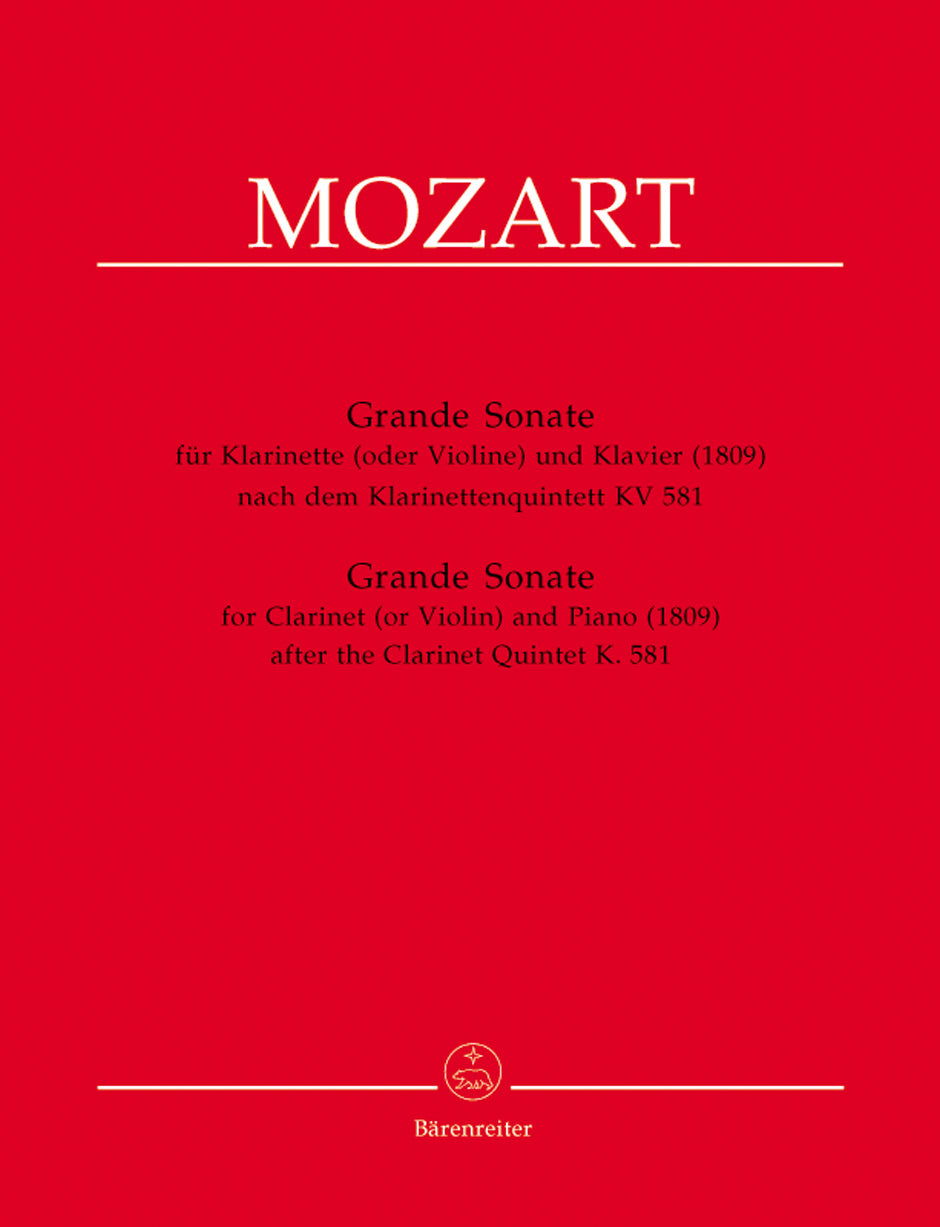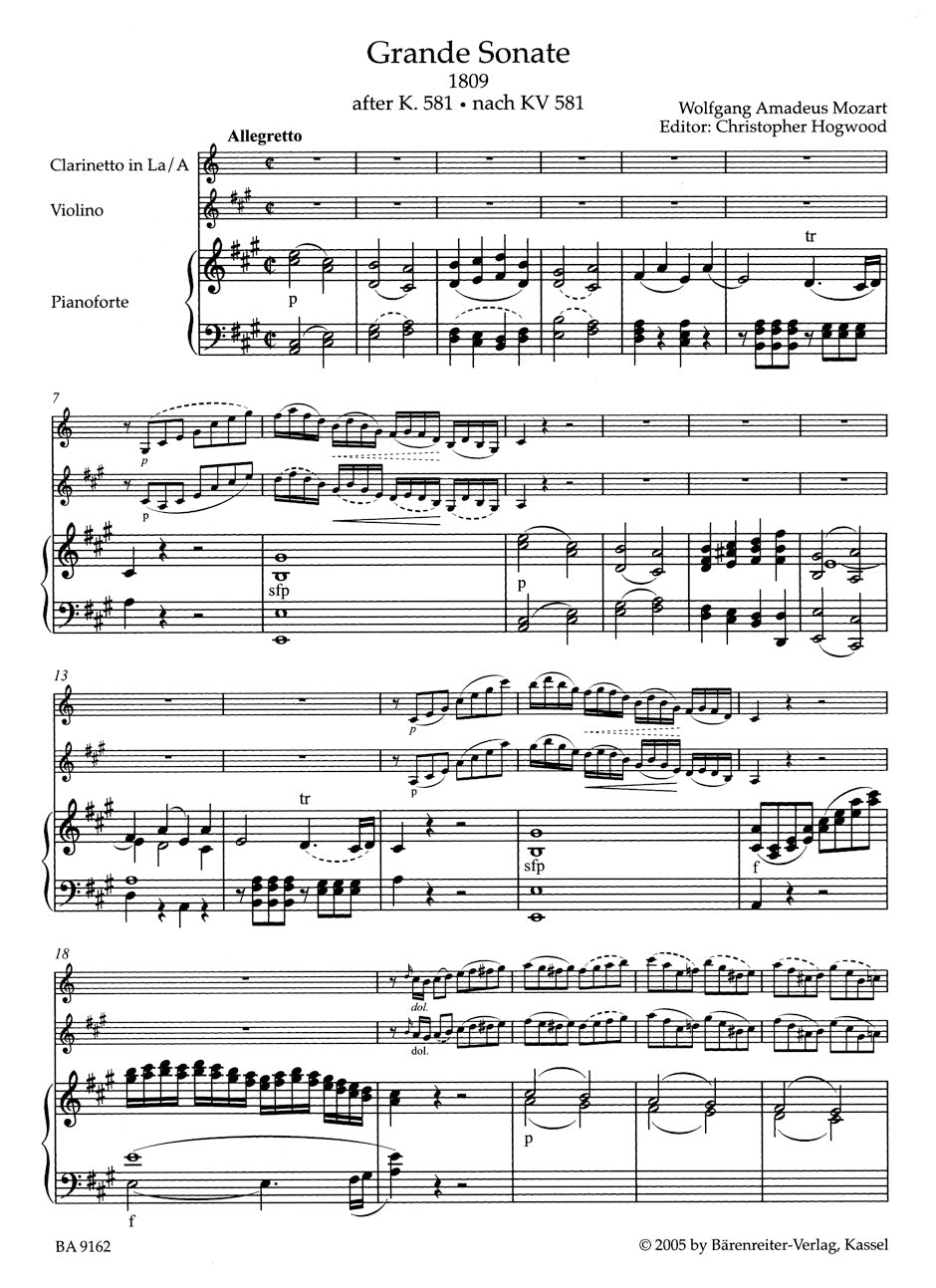Mozart: Grande Sonata for Clarinet (or Violin) and Piano in A Major
after the Clarinet Quintet, K. 581
In stock and typically ships within 1 business day.
- Composer: Wolfgang Amadeus Mozart (1756-1791)
- Editor: Christopher Hogwood (1941-2014)
- Format: Set of Parts
- Instrumentation: Piano, Clarinet
- ISMN:
- Size: 9.1 x 11.8 inches
- Pages: 47
Description
Includes parts for both clarinet and violin.
In the 25 years following Mozart's death an enormous amount of his music was arranged and adapted for the insatiable appetite of the European musical public. Nearly every Major work was arranged for piano four hand, even some of the operas were arranged for string quartet or other chamber scoring.
The arrangements are of highly popular Mozart chamber compositions, the Quintet for Clarinet and String Quartet, K. 581 in an anonymous arrangement from 1809 for Clarinet (or Violin) and Piano as well as Mozart's two duos for Violin and Viola, K. 423-424 arranged by Johannes Traeg in 1805 for Violin and Cello.
The "Grande Sonata" for Clarinet (or Violin) and Piano, published by Artaria, is an early arrangement of a Mozart work of which no autograph exists.
The editor, Christopher Hogwood, weaves together the patchwork of sources for the quintet , justifying this arrangement for clarinet and piano as a serious source for the work.
Johannes Traeg , an acquaintance of Mozart's and a publisher, quickly responded to the public demand for domestic Mozart arrangements at the start of the 19th century.
His arrangements of the Violin – Viola duos, K. 423-424 for Violin and Cello, published in 1805, are a response to the need for a more active cello part in chamber music.
Dietrich Berke, editor of the "New Mozart Edition" and editor of the NMA volume containing the duos, clearly shows the path from the Mozart autograph to the arrangement and offers us an informative preface on the duos and their place in domestic music making at the turn of the 19thcentury.
Publishers use a lot of words to describe what they sell, and we know it can be confusing. We've tried to be as clear as possible to make sure you get exactly what you are looking for. Below are descriptions of the terms that we use to describe the various formats that music often comes in.
Choral Score
A score for vocalists that only contains the vocal lines. The instrumental parts are not there for reference. Generally, cheaper than a vocal score and requires multiple copies for purchase.
Facsimile
Reproductions of the original hand-written scores from the composer.
Full Score
For ensemble music, this indicates that the edition contains all parts on a single system (there are not separate parts for each player). In larger ensembles, this is for the conductor.
Hardcover
Hardbound. Generally either linen-covered or half-leather.
Orchestral Parts
Similar to a wind set, this is a collection of parts. In the case of strings, the numbers listed are the number of copies included, though generally these are available individually (often with minimum quantities required).
Paperback
When publishers offer multiple bindings (e.g. hardcover) or study scores, this is the "standard" version. If you're planning to play the music, this is probably what you want.
Performance / Playing Score
A score of the music containing all parts on one system, intended for players to share. There are not separate parts for each player.
Set of Parts
For ensemble music, this indicates that there are separate individual parts for each player.
Solo Part with Piano Reduction
For solo pieces with orchestra, this is a version that contains a piano reduction of the orchestra parts. For piano pieces, two copies are typically needed for performance.
Study Score
A small (think choral size) copy of the complete score meant for studying, and not playing. They make great add-ons when learning concertos and small chamber works.
Vocal Score
A score prepared for vocalists that includes the piano/organ part or a reduction of the instrumental parts.
Wind Set
For orchestral music, this is a collection of wind and percussion parts. The specific quantities of each instrument are notated.
With Audio
In addition to the printed music, the edition contains recordings of the pieces. This may be an included CD, or access to files on the internet.
With / Without Fingering (Markings)
Some publishers prepare two copies - a pure Urtext edition that includes no fingering (or bowing) suggestions and a lightly edited version that includes a minimal number of editorial markings.




